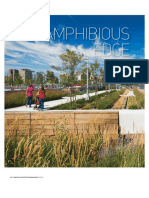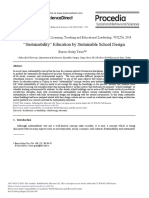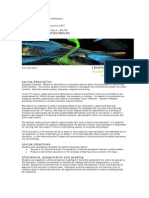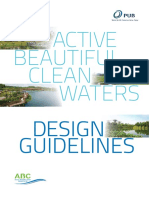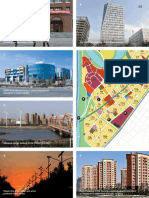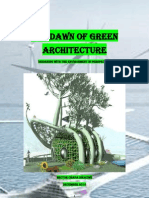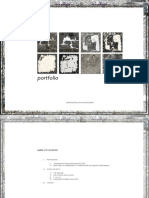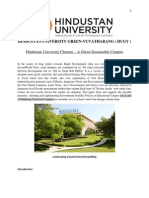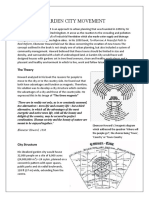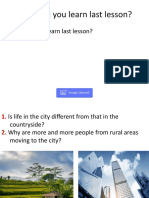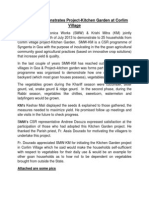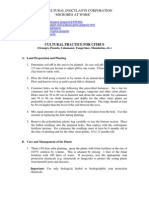Adapting Cities For Climate Change The Role of The
Adapting Cities For Climate Change The Role of The
Uploaded by
Anastasiia Sin'kovaCopyright:
Available Formats
Adapting Cities For Climate Change The Role of The
Adapting Cities For Climate Change The Role of The
Uploaded by
Anastasiia Sin'kovaOriginal Title
Copyright
Available Formats
Share this document
Did you find this document useful?
Is this content inappropriate?
Copyright:
Available Formats
Adapting Cities For Climate Change The Role of The
Adapting Cities For Climate Change The Role of The
Uploaded by
Anastasiia Sin'kovaCopyright:
Available Formats
See discussions, stats, and author profiles for this publication at: https://www.researchgate.
net/publication/253064021
Adapting Cities for Climate Change: The Role of the Green Infrastructure
Article in Built Environment · March 2007
DOI: 10.2148/benv.33.1.115
CITATIONS READS
1,377 7,198
4 authors, including:
Susannah Gill Roland Ennos
The Mersey Forest University of Hull
12 PUBLICATIONS 1,761 CITATIONS 167 PUBLICATIONS 9,591 CITATIONS
SEE PROFILE SEE PROFILE
Stephan Pauleit
Technische Universität München
225 PUBLICATIONS 7,683 CITATIONS
SEE PROFILE
Some of the authors of this publication are also working on these related projects:
Investigating the mechanics of splitting of wood and its implications for the design of Neolithic axes and other eraly woodworking tools View project
LOS_DAMA! - Landscape and Open Space Development in Alpine Metropolitan Areas View project
All content following this page was uploaded by Susannah Gill on 10 April 2014.
The user has requested enhancement of the downloaded file.
ADAPTING CITIES FOR CLIMATE CHANGE: THE ROLE OF THE GREEN INFRASTRUCTURE
Adapting Cities for Climate Change:
The Role of the Green Infrastructure
S.E. GILL, J.F. HANDLEY, A.R. ENNOS and S. PAULEIT
The urban environment has distinctive biophysical features in relation to
surrounding rural areas. These include an altered energy exchange creating an
urban heat island, and changes to hydrology such as increased surface runoff of
rainwater. Such changes are, in part, a result of the altered surface cover of the
urban area. For example less vegetated surfaces lead to a decrease in evaporative
cooling, whilst an increase in surface sealing results in increased surface runoff.
Climate change will amplify these distinctive features. This paper explores the
important role that the green infrastructure, i.e. the greenspace network, of a
city can play in adapting for climate change. It uses the conurbation of Greater
Manchester as a case study site. The paper presents output from energy exchange
and hydrological models showing surface temperature and surface runoff in
relation to the green infrastructure under current and future climate scenarios. The
implications for an adaptation strategy to climate change in the urban environment
are discussed.
Introduction and the UK Climate Impacts Programme
(UKCIP) have established a research pro-
Much of the emphasis in planning for gramme into Building Knowledge for a
climate change is, quite properly, focused Changing Climate (BKCC). One project
on reducing or mitigating greenhouse gas within the BKCC programme, Adaptation
emissions. Present day emissions will impact Strategies for Climate Change in the Urban
on the severity of climate change in future Environment (ASCCUE), is developing ways
years (Hulme et al., 2002). However, climate of preparing for climate change through
change is already with us. The World Wide strategic planning and urban design. One
Fund for Nature, for example, has recently important facet of ASCCUE, which is
drawn attention to the significant warming the subject of this paper, is to explore the
of capital cities across Europe (WWF, 2005). potential of urban greenspace in adapting
Due to the long shelf-life of carbon dioxide in cities to climate change.
the atmosphere, much of the climate change In 1991, 90 per cent of people in Great
over the next 30 to 40 years has already been Britain lived in urban areas (Denham and
determined by historic emissions (Hulme et White, 1998) and it is here that climate
al., 2002). Thus, there is a need to prepare change impacts will be felt. Urban areas
for climate change that will occur whatever have distinctive biophysical features in
the trajectory of future greenhouse gas comparison with surrounding rural areas
emissions. (Bridgman et al., 1995). For example, energy
With this in mind the UK Engineering and exchanges are modified to create an urban
Physical Sciences Research Council (EPSRC) heat island, where air temperatures may
BUILT ENVIRONMENT VOL 33 NO 1 115
CLIMATE CHANGE AND CITIES
be several degrees warmer than in the noted that these climate change scenarios do
countryside (Wilby, 2003; Graves et al., 2001). not take urban surfaces into account. There
The magnitude of the urban heat island is likely to be significant urban warming
effect varies in time and space as a result of over and above that expected for rural areas
meteorological, locational and urban chara- (Wilby and Perry, 2006; Wilby, 2003).
cteristics (Oke, 1987). Hydrological processes Climate change will impact on the urban
are also altered such that there is an increase environment. These impacts are felt by both
in the rate and volume of surface runoff of people and the built infrastructure. For
rainwater (Mansell, 2003; Whitford et al., example, it is estimated that the European
2001). summer heat wave in 2003 claimed 35,000
Such biophysical changes are, in part, a lives (Larsen, 2003). Incidents of flooding
result of the altered surface cover of the urban also result in both physical and psychological
area (Whitford et al., 2001). Urbanization illnesses (e.g. Reacher et al., 2004; Baxter et
replaces vegetated surfaces, which provide al., 2002; Shackley et al., 2001). In addition,
shading, evaporative cooling, and rainwater buildings are vulnerable to flooding depend-
interception, storage and infiltration func- ing on their location (Graves and Phillipson,
tions, with impervious built surfaces. How- 2000).
ever, urban greenspaces provide areas within The biophysical features of greenspace in
the built environment where such processes urban areas, through the provision of cooler
can take place (Whitford et al., 2001). These microclimates and reduction of surface water
ecosystem services (Daily, 1997) provided runoff, therefore offer potential to help adapt
by urban greenspace are often overlooked cities for climate change. However, little is
and undervalued. For example, trees are known about the quantity and quality of
felled for the perceived threat they pose near greenspace required. The green infrastructure
highways and buildings (Biddle, 1998), infill is ‘an interconnected network of green space
development takes place on former gardens, that conserves natural ecosystem values and
front gardens are paved over to provide functions and provides associated benefits to
parking spaces for cars, and biodiverse urban human populations’ (Benedict and McMahon,
‘wasteland’ is earmarked for redevelopment 2002, p. 12). The green infrastructure should
(e.g. Duckworth, 2005; GLA, 2005; Pauliet et operate at all spatial scales from urban centres
al., 2005). to the surrounding countryside (URBED,
In a changing climate the functionality 2004).
provided by urban greenspace becomes in- The aim of this paper is to explore the
creasingly important. In the UK, climate potential of green infrastructure in adapt-
change scenarios (UKCIP02) suggest average ing cities for climate change. This will be
annual temperatures may increase by between achieved through a characterization of the
1°C and 5°C by the 2080s, with summer case study site, and quantifying its en-
temperatures expected to increase more than vironmental functions under both current
winter temperatures. There will also be a and future climate scenarios, as well as with
change in the seasonality of precipitation, differing patterns of green cover.
with winters up to 30 per cent wetter by the
2080s and summers up to 50 per cent drier.
Case Study Site
These figures are dependent on both the
region and emissions scenario (Hulme et al., Greater Manchester, selected as the case study
2002). Precipitation intensity also increases, site, is representative of a large conurbation
especially in winter and the number of very (population 2.5 million) in Britain and
hot days increases, especially in summer Northern Europe. The Metropolitan County
and autumn (Hulme et al., 2002). It should be of Greater Manchester, located in north-
116 BUILT ENVIRONMENT VOL 33 NO 1
ADAPTING CITIES FOR CLIMATE CHANGE: THE ROLE OF THE GREEN INFRASTRUCTURE
west England, is administered by ten local industrial cities and the end of that era
authorities: Bolton, Bury, Manchester, Old- was marked by extensive dereliction and
ham, Rochdale, Salford, Stockport, Tameside, abandoned transport infrastructure. During
Trafford, and Wigan. There is some coordina- the past two decades there has been a change
tion at the conurbation level through the in the fortune of the conurbation with large-
Association of Greater Manchester Authori- scale urban regeneration projects transforming
ties, but planning powers at the larger land, water and buildings to new uses.
scale are vested in the North West Regional Urban expansion is restricted by Green Belt
Assembly (NWRA). The NWRA prepares designation and new development is focused
a Regional Spatial Strategy (NWRA, 2006), on previously developed, brownfield land.
which is the broad planning framework for There is also pressure for infill development
the region, whilst the municipalities each in lower density residential areas, especially
prepare a Local Development Framework in south Manchester.
which provides a more detailed template for
development.
Urban Characterization
Greater Manchester covers an area of
approximately 1300 km2 and has developed The first stage of the research was to
on a river basin flanked by the Pennine hills. characterize the urban environment. This
The altitudinal range is between 10 m and involved the mapping of urban morphology
540 m above sea level. Greater Manchester types (UMTs) (LUC, 1993) followed by a
offers sufficient size for full expression of surface cover analysis. The UMTs effectively
urban environmental character, contrasting serve as integrating spatial units linking
soil types, a range of neighbourhood and human activities and natural processes. The
land-use types (including restructuring and assumption is that UMTs have characteristic
urban extension areas with substantial scope physical features and are distinctive according
for climate change adaptation), as well as a to the human activities that they accom-
range of built forms. modate (i.e. land uses). Greater Manchester
Manchester was one of the world’s first was stratified into 29 distinctive UMTs,
Table 1. Primary and detailed UMT categories.
Primary UMT category Detailed UMT categories
Farmland Improved farmland, unimproved farmland
Woodland Woodland
Minerals Mineral workings and quarries
Recreation and leisure Formal recreation, formal open space, informal open space, allotments
Transport Major roads, airports, rail, river and canal
Utilities and infrastructure Energy production and distribution, water storage and treatment, refuse
disposal, cemeteries and crematoria
Residential High-density residential, medium-density residential, low-density
residential
Community services Schools, hospitals
Retail Retail, town centre
Industry and business Manufacturing, offices, distribution and storage
Previously developed land Disused and derelict land
Defence Defence
Unused land Remnant countryside
BUILT ENVIRONMENT VOL 33 NO 1 117
CLIMATE CHANGE AND CITIES
digitized in ArcView GIS from 1997 aerial Some 506 km2, or just under 40 per cent, of
photographs (resolution: 0.25 m, source: Greater Manchester is farmland, with the
Cities Revealed). These were grouped into remaining 60 per cent (793 km2) representing
12 primary UMT categories (table 1). the ‘urbanized’ area. Residential areas account
The primary UMT map for Greater for just under half of the urbanized area, or
Manchester (figure 1) shows the locations of 29 per cent of Greater Manchester, and can
the various town centres, grouped under the thus be viewed from a landscape ecology
primary UMT category of retail, in Greater perspective as the ‘matrix’ – representing the
Manchester. These are largely surrounded by dominant landscape category in the urban
residential areas. Higher-density residential mosaic (Forman and Godron, 1986).
areas are typically located closer to the town Whilst the UMT categories provide an initial
centres. Trafford Park, a major industrial indication of where patches of green may be
and retail area, can be seen to the west of expected, e.g. in formal and informal open
Manchester city centre. The main transport spaces, and where green corridors may be
infrastructure, including Manchester airport found, e.g. alongside roads, railways, rivers
in the south and Manchester ship canal to the and canals, they do not reveal the extent
west, are clearly visible. Farmland surrounds of green cover within the built matrix of
the urban core and in certain instances the conurbation. Thus, the surface cover
extends into the urban areas. Towards the of each of the 29 UMT categories was then
south of the conurbation the open land of the estimated by aerial photograph interpretation
Mersey valley forms a greenspace corridor of random points (Akbari et al., 2003). This
intersecting the mainly residential areas. is very important as the surface cover affects
Figure 1. Primary Urban
Morphology Type map of
Greater Manchester.
118 BUILT ENVIRONMENT VOL 33 NO 1
ADAPTING CITIES FOR CLIMATE CHANGE: THE ROLE OF THE GREEN INFRASTRUCTURE
the environmental performance of the over Greater Manchester and 16 per cent in
conurbation (Pauliet et al., 2005; Nowak et ‘urbanized’ Greater Manchester. Whilst the
al., 2001; Whitford et al., 2001; Pauliet and woodland UMT category has 70 per cent
Duhme, 2000). Nine surface cover types were trees, all other UMTs have below 30 per cent
used: building, other impervious, tree, shrub, tree cover. Town centres have a tree cover of
mown grass, rough grass, cultivated, water, 5 per cent.
and bare soil/ gravel. Particular attention must be given to the
The results indicate that on average 72 surface cover in residential areas, as these
per cent of Greater Manchester, or 59 per cover almost half of ‘urbanized’ Greater
cent of the ‘urbanized’ area, consists of Manchester and therefore have a great
evapotranspiring (i.e. vegetated and water) impact on the environmental performance
surfaces (figure 2). All the UMT categories of the conurbation. Approximately 40 per
have, on average, more than 20 per cent cent of all the evapotranspiring surfaces
evapotranspiring surfaces. However, there is in ‘urbanized’ Greater Manchester occur
considerable variation across the UMTs. Town in residential areas, with medium-density
centres have the lowest evapotranspiring residential areas accounting for the majority
cover of 20 per cent compared to woodlands of such surfaces. The three types of residential
with the highest cover of 98 per cent. In area have different surface covers from each
general, the proportion of tree cover is other (figure 3). In high-density residential
fairly low, covering on average 12 per cent areas built surfaces (i.e. building and other
Figure 2. Proportion of evapotranspiring (i.e. vegetated and water) surfaces in Greater Manchester.
BUILT ENVIRONMENT VOL 33 NO 1 119
CLIMATE CHANGE AND CITIES
Figure 3. Proportional surface cover in high-, medium- and low-density residential UMTs.
impervious surfaces) cover about two- significant factor in determining human
thirds of the area, compared to about half in comfort, especially on hot days with little
medium-density areas and one-third in low- wind (Matzarakis et al., 1999). Whitford et
density areas. Tree cover is 26 per cent in low- al. (2001) therefore considered surface tem-
density areas, 13 per cent in medium-density perature to be an effective indicator for
areas, and 7 per cent in high-density areas. energy exchange in the urban environment.
As well as requiring input of the proportional
area covered by built and evapotranspiring
Quantifying the Environmental Functions
(i.e. all vegetation and water) surfaces, the
The UMTs, with their distinctive surface model also requires a building mass per
covers, formed one of the inputs into unit of land, and various meteorological
energy exchange and surface runoff models parameters including air temperature.
(Whitford et al., 2001). The energy exchange The surface runoff model uses the curve
model has maximum surface temperature number approach of the US Soil Conservation
as its output and is based on an energy Service (Whitford et al., 2001; USDA Natural
balance equation (Whitford et al., 2001; Tso Resources Conservation Service, 1986). Again,
et al., 1990, 1991). The warming of the urban surface cover is required as an input along
environment in summer is an important with precipitation, antecedent moisture
issue because of its implications for human conditions, and hydrologic soil type.
comfort and well being (e.g. Svensson and The models were run for the baseline
Eliasson, 2002; Eliasson, 2000). Whilst air 1961–1990 climate, as well as for the
temperature provides a simple estimator of UKCIP02 Low and High emissions scenarios
human thermal comfort, it is less reliable for the 2020s, 2050s, and 2080s (Hulme et
outdoors owing to the variability of other al., 2002). Results presented here are for
factors such as humidity, radiation, wind, and the 1961–1990 baseline and the 2080s Low
precipitation (Brown and Gillespie, 1995). In and High emissions scenarios. Temperature
practice, the mean radiant temperature, which and precipitation inputs were calculated
in essence is a measure of the combined effect for the different time periods and emissions
of surface temperatures within a space, is a scenarios using daily time series output from
120 BUILT ENVIRONMENT VOL 33 NO 1
ADAPTING CITIES FOR CLIMATE CHANGE: THE ROLE OF THE GREEN INFRASTRUCTURE
a weather generator for Ringway (Manchester (Duckworth, 2005; Pauleit et al., 2005), as
Airport) (BETWIXT, 2005; Watts et al., 2004a). well as to explore the potential of greening
The energy exchange model used the 98th to help adapt urban areas to climate change.
percentile average daily summer temperature They included: residential and town centres
for its input, or the average temperature plus or minus 10 per cent green or tree cover;
occurring on approximately two days per greening roofs in selected UMTs; high-density
summer. The surface runoff model used the residential development on previously
99th percentile winter daily precipitation as developed land; increasing tree cover by
its input, a precipitation event that occurs 10–60 per cent on previously developed
approximately once per winter. The 99th land; residential development on improved
percentile daily winter precipitation is 18 farmland; and permeable paving in selected
mm for 1961–1990, 25 mm for the 2080s Low, UMTs. In addition, for the energy exchange
and 28 mm for the 2080s High. Results of model, runs were completed where grass
the surface runoff model presented here are was excluded from the evapotranspiring
for normal antecedent moisture conditions. proportion. This was intended to give some
However, analysis of the weather generator indication of the impact of a drought, when
output suggests that antecedent moisture the water supply is limited and plants
conditions in winter become wetter with evapotranspire less, and hence their cooling
climate change. effect is lost. Grass may be the first type of
Model runs were completed for the UMT vegetation in which this happens due to its
categories with their current form, i.e. using shallow rooting depth.
proportional surface covers from the urban
characterization, as well as for a series of
Energy Exchange Model
‘development scenarios’ exploring the impact
on environmental functionality of adding and The maximum surface temperature is very
taking away green cover in key areas in the dependent on the proportion of green cover
conurbation. The ‘development scenarios’ (figure 4). This will become increasingly
were intended both to help understand important in the future. Currently the maxi-
the effects of current development trends mum surface temperature of woodlands, the
Figure 4. Maximum surface
temperature in Greater
Manchester for the 98th
percentile summer day in
1961–1990 and the 2080s
Low and High emissions
scenarios.
BUILT ENVIRONMENT VOL 33 NO 1 121
CLIMATE CHANGE AND CITIES
least built up UMT, is 18.4°C, 12.8°C cooler maximum surface temperatures at or below
than that of town centres, the most built the 1961–1990 baseline temperatures up to,
up UMT, at 31.2°C. The maximum surface but not including, the 2080s High emissions
temperatures are 19.9°C in woodlands and scenario (figures 5 and 6). In high-density
33.2°C in town centres by the 2080s Low and residential areas, for example, maximum
21.6°C and 35.5°C by the 2080s High. Thus, surface temperatures in 1961–1990 with
by the 2080s there are increases in maximum current form are 27.9°C. Adding 10 per cent
surface temperature of between 1.5°C and green cover decreases maximum surface tem-
3.2°C in woodlands and 2°C to 4.3°C in town peratures by 2.2°C in 1961–1990, and 2.4°C to
centres, depending on the emissions scenario. 2.5°C by the 2080s Low and High emissions
The difference in temperatures between these scenarios, respectively. Thus, maximum
extreme UMTs also increases to 13.9°C by the surface temperatures decrease by 0.7°C by the
2080s High. In high-density residential areas, 2080s Low and increase by 1.2°C by the 2080s
with an evaporating cover of 31 per cent, High, in comparison to the 1961–1990 current
maximum surface temperatures increase by form case. This is compared to temperature
1.7°C and 3.7°C by the 2080s, depending on increases of 1.7°C to 3.7°C by the 2080s Low
emissions scenario; in low-density areas, and High if no change was made to surface
with an evaporating cover of 66 per cent, the cover. On the other hand, if 10 per cent
increase is 1.4°C to 3.1°C. The temperature green cover is removed maximum surface
difference between these residential UMTs is temperatures by the 2080s High emissions
6.2°C in 1961–1990, and 6.5°C to 6.8°C by the scenario are 7°C and 8.2°C warmer in
2080s, depending on the emissions scenario. high-density residential and town centres,
Adding 10 per cent green cover to areas respectively, compared to the 1961–1990
with little green, such as the town centre current form case (figures 5 and 6).
and high-density residential UMTs keeps Adding green roofs to all buildings can
Figure 5. Maximum surface temperature for the 98th percentile summer day in high-density residential
areas, with current form and when 10 per cent green cover is added or removed. Dashed line shows the
temperature for the 1961–1990 current form case.
122 BUILT ENVIRONMENT VOL 33 NO 1
ADAPTING CITIES FOR CLIMATE CHANGE: THE ROLE OF THE GREEN INFRASTRUCTURE
Figure 6. Maximum surface temperature for the 98th percentile summer day in town centres, with
current form and when 10 per cent green cover is added or removed. Dashed line shows the temperature
for the 1961–1990 current form case.
have a dramatic effect on maximum surface is high and the evaporating fraction is low.
temperatures, keeping temperatures below Thus, the largest difference was made in the
the 1961–1990 current form case for all time town centres followed by manufacturing,
periods and emissions scenarios (figure 7). high-density residential, distribution and
Roof greening makes the biggest difference storage, and retail. The difference made by
in the UMTs where the building proportion the roof greening becomes greater with the
Figure 7. Maximum surface temperature for the 98th percentile summer day in selected UMTs, with
current form and when all roofs are greened.
BUILT ENVIRONMENT VOL 33 NO 1 123
CLIMATE CHANGE AND CITIES
Figure 8. Increase in
maximum surface
temperature for selected
UMTs for the 98th percentile
summer day when grass
dries out and stops
evapotranspiring.
time period and emissions scenario. For evapotranspiring, rivers and canals become
example, in 1961–1990, greening roofs results the coolest UMT, with maximum surface
in maximum surface temperatures of 24.6°C temperatures of 19.8°C in 1961–1990 and
in town centres, a decrease of 6.6°C compared 22.9°C by the 2080s High, followed by wood-
to the current form case of 31.2°C. By the lands. The UMTs experiencing the biggest
2080s High, greening roofs in town centres change in maximum surface temperature
results in temperatures of 28°C, 7.6°C less when grass dries out are those where it
than if roofs are not greened and 3.3°C less forms a large proportion of the evaporating
than the 1961–1990 current form case. fraction (figure 8). For example, in schools
In contrast, when grass dries and stops which often have large playing fields, the
Figure 9. Runoff coefficients for selected UMTs under normal antecedent moisture conditions on a fast
and slow infiltrating soil. Vertical dashed lines show the 99th percentile daily winter precipitation for
1961–1990 (18 mm), the 2080s Low (25 mm), and the 2080s High (28 mm).
124 BUILT ENVIRONMENT VOL 33 NO 1
ADAPTING CITIES FOR CLIMATE CHANGE: THE ROLE OF THE GREEN INFRASTRUCTURE
maximum surface temperature increases by which have the highest runoff coefficients of
13.8°C in 1961–1990 and 15.6°C by the 2080s all the UMTs. On a clay soil this changes to
High. 76 per cent and 90 per cent respectively, much
higher values and with a smaller difference
between them. Thus, surface sealing has a
Surface Runoff Model
more significant impact on runoff on a sandy
In general, the more built up a UMT category soil with a high infiltration rate than on a clay
is the more surface runoff there will be. soil with a low infiltration rate.
Additionally, soil type is very important With the increasing precipitation expected
(figure 9). Faster infiltrating soils, such as by the 2080s there will be increased surface
sandy soils, have lower runoff coefficients runoff (figure 10). Not only will there be
than slower infiltrating soils, such as clays. higher precipitation but a larger percentage
The runoff coefficients display the largest of the precipitation will contribute to
range on high infiltration soils and the surface runoff. The total runoff over Greater
smallest range on low infiltration soils. For Manchester for an 18 mm rainfall event, the
example, for an 18 mm precipitation event on 99th percentile winter daily precipitation in
sandy soil, low-density residential UMTs will 1961–1990, is 13.8 million m3. Yet for the 28
have 32 per cent runoff compared with 74 per mm rainfall event, expected by the 2080s
cent from the more built up town centres, High, which has 55.6 per cent more rain
Figure 10. Surface runoff over Greater Manchester from 99th percentile daily winter precipitation with
normal antecedent moisture conditions in 1961–1990 and the 2080s Low and High emissions scenarios.
BUILT ENVIRONMENT VOL 33 NO 1 125
CLIMATE CHANGE AND CITIES
Figure 11. Runoff from
high-density residential
with current form and
plus or minus 10 per cent
green or trees, with normal
antecedent moisture
conditions. Vertical dashed
lines show the 99th
percentile daily winter
precipitation for 1961–1990
(18 mm), the 2080s Low (25
mm), and the 2080s High
(28 mm).
than the 18 mm event, the total Greater 1961–1990 current form case. In fact, runoff
Manchester runoff increases by 82.2 per cent from high-density residential areas will still
to 25.2 million m3. The total runoff from be approximately 65 per cent higher by the
‘urbanized’ Greater Manchester is 8.9 million 2080s High even when green cover is added,
m3 for an 18 mm rainfall event compared to when compared to the 1961–1990 current
16.0 million m3 for a 28 mm rainfall event. form case. This ‘development scenario’ does
Increasing green cover by 10 per cent in the not have a very large impact on the total
residential UMTs reduces runoff from these runoff over Greater Manchester; however,
areas from a 28 mm precipitation event, it must be remembered that residential areas
expected by the 2080s High, by 4.9 per cent; cover 29 per cent of Greater Manchester.
increasing tree cover by the same amount Thus, changing 10 per cent of the surface
reduces the runoff by 5.7 per cent (figure cover in residential areas in fact only alters
11). While increasing green or tree cover by 2.9 per cent of the surface of the conurbation.
10 per cent helps to deal with the increased Adding 10 per cent tree cover to residential
precipitation, it cannot keep the future runoff areas reduces total Greater Manchester runoff
at or below the runoff levels for the baseline by only 1.9 per cent for a 28 mm event.
Figure 12. Runoff for
selected UMTs with and
without green roofs added,
vertical dashed lines show
the 99th percentile daily
winter precipitation for
1961–1990 (18 mm), the
2080s Low (25 mm), and the
2080s High (28 mm).
126 BUILT ENVIRONMENT VOL 33 NO 1
ADAPTING CITIES FOR CLIMATE CHANGE: THE ROLE OF THE GREEN INFRASTRUCTURE
Adding green roofs to all the buildings strategy to keep surface temperatures below
in town centres, retail, and high-density the baseline level for all time periods and
residential UMTs significantly reduces runoff emissions scenarios. On the other hand,
from these areas (figure 12). The effect is the modelling work highlights the dangers
greatest where there is a high building cover. of removing green from the conurbation.
When green roofs are added, the runoff from For example, if green cover in high-density
an 18 mm rainfall event for these UMTs residential areas and town centres is reduced
is reduced by 17.0–19.9 per cent. Even for by 10 per cent, surface temperatures will
the 28 mm event runoff can be reduced by be 7°C or 8.2°C warmer by the 2080s High
11.8–14.1 per cent by adding green roofs. in each, when compared to the 1961–1990
By the 2080s High, when compared to the baseline case; or 3.3°C and 3.9°C when
1961–1990 current form cases, adding green compared to the 2080s High case where green
roofs to town centres, retail, and high-density cover stays the same.
residential UMTs limits the increase in runoff Thus, one possible adaptation strategy to
to 43.6 per cent, 47.2 per cent and 44 per cent, increasing temperatures is to preserve existing
respectively. This is compared to 65.5 per areas of greenspace and to enhance it where
cent, 67 per cent and 67.6 per cent for these possible, whether in private gardens, public
areas if no green roofs were added. spaces or streets. For example in Housing
Green roofs reduce the total Greater Market Renewal Areas or in the Growth
Manchester runoff for an 18 mm precipitation Areas, significant new greenspaces should
event by 0.6 per cent, 0.1 per cent, and 1.0 per be created. These initiatives are part of the
cent when added to town centres, retail, and UK government’s Sustainable Communities
high-density residential, respectively; for a Programme. Nine Housing Market Renewal
28 mm event the reductions are 0.4 per cent, Areas have been identified by the govern-
0.1 per cent, and 0.7 per cent, respectively. ment across the North of England and the
Whilst these figures seem small, it must be Midlands, including Manchester/Salford
remembered that town centres, retail, and and Oldham/Rochdale, with the objective of
high-density residential cover 2.1 per cent, renewing failing housing markets through
0.5 per cent and 3.7 per cent of Greater refurbishment, replacement and new build of
Manchester, respectively. houses. The Growth Areas are in South East
England and will provide as many as 200,000
new homes to relieve housing pressures in the
Climate Adaptation via the
region (DCLG, no date). Given the long life
Green Infrastructure
time of buildings, from 20 to over 100 years
The modelling work presented here suggests (Graves and Phillipson, 2000), it is crucial to
that the use of urban greenspace offers take opportunities for creating greenspaces
significant potential in moderating the as they arise.
increase in summer temperatures expected However, in many existing urban areas
with climate change. Adding 10 per cent where the built form is already established,
green in high-density residential areas and it is not feasible to create large new green-
town centres kept maximum surface tem- spaces. Thus, greenspace will have to be
peratures at or below 1961–1990 baseline added creatively by making the most of
levels up to, but not including, the 2080s all opportunities, for example through the
High. Greening roofs in areas with a high greening of roofs, building façades, and
proportion of buildings, for example in railway lines, street tree planting, and con-
town centres, manufacturing, high-density verting selected streets into greenways.
residential, distribution and storage, and Priority should be given to areas where the
retail, also appeared to be an effective vulnerability of the population is highest. A
BUILT ENVIRONMENT VOL 33 NO 1 127
CLIMATE CHANGE AND CITIES
study in Merseyside found that vegetation, irrigation measures must be considered to
and in particular tree cover, is lower in ensure that they have an adequate water
residential areas with higher levels of socio- supply. This could be through rainwater
economic deprivation (Pauleit et al., 2005). harvesting, the re-use of greywater, making
The socio-economic deprivation index used use of water in rising aquifers under cities
included variables relating to health depri- where present, and floodwater storage.
vation. Such populations will therefore be Unless adequate provision is made there
more vulnerable to the impacts of climate will be conflict as greenspace will require
change. irrigating at the same time as water supplies
One caveat to the potential of green cover are low and restrictions may be placed on its
in moderating surface temperatures is the use. Ironically, measures which are currently
case of a drought, when grass dries out in hand to reduce leakage in the water supply
and loses its evaporative cooling function. system may reduce available water for street
Output from the daily weather generator trees which are critically important for human
used suggests that with climate change comfort in the public realm.
there will be more consecutive dry days and There may be other potential conflicts
heat waves of longer duration in summer arising from planting trees in proximity to
(BETWIXT, 2005; Watts et al., 2004a, 2004b). buildings. On clay soils in particular, changes
Similarly, research undertaken as part of the in soil moisture content, as may occur with
ASCCUE project to map drought risk through climate change, result in dimensional changes
the combination of available water in the in the soil (Percival, 2004). If changes occur
soils, precipitation and evapotranspiration, below the foundation level of the buildings,
suggests a significant increase in the this can result in damage. However, the
duration of droughts with climate change. persistence of a moisture deficit beyond
Thus, it is likely that there will be more cases seasonal fluctuations only occurs in extreme
when the grass loses its evaporative cooling cases. Tree roots are involved in at least 80
function unless counter measures are taken. per cent of subsidence claims on shrinkable
In such situations the role of water surfaces clay soils, yet even on clay soils the risk of a
in providing cooling and trees in providing tree causing damage is less than 1 per cent
shade become increasingly important. The (Biddle, 1998). Biddle (1998) argues that,
modelling work presented here does not due to the importance of trees in urban
include the effect of shading on surface environments, a proper understanding is
temperatures. A pilot study undertaken by required of the mechanism of damage, how
the ASCCUE project suggests that the shade this can be prevented, and of appropriate
provided by mature trees can keep surfaces remedies if damage occurs. An approach
cooler by as much as 15.6°C. which accepts that minor damage may
One possible adaptation strategy would sometimes occur, and then remedies the
be drought-resistant plantings. In Greater situation if it does, is the most appropriate.
Manchester this would involve planting In addition, new buildings should include
vegetation, such as trees, that is less sensitive precautions in the design and construction
than grasslands to drought. Trees are common of foundations to allow for tree growth near
in open spaces in the Mediterranean. Tree buildings (Biddle, 1998).
species which are less sensitive to drought The modelling work suggests that
can be chosen from temperate zones, such greenspace on its own is less effective at
that they will still evapotranspire and moderating the volume of surface runoff
provide shade. Site conditions for trees in under climate change. While greenspace
streets may need improving so that there helps to reduce surface runoff, especially at a
is sufficient rooting space. In addition, local level, the increase in winter precipitation
128 BUILT ENVIRONMENT VOL 33 NO 1
ADAPTING CITIES FOR CLIMATE CHANGE: THE ROLE OF THE GREEN INFRASTRUCTURE
brought by climate change is such that runoff courses and nature reserves alongside the
increases regardless of changes to surface River Mersey are used as flood storage basins
cover. Thus, in order to adapt to the increased at times of high river flow (Sale Community
winter precipitation expected with climate Web, no date). On the other hand, the matrix
change, greenspace provision will need to be is especially important when it comes
considered alongside increased storage. There to rainwater infiltration, as are patches.
is significant potential to utilize sustainable Greenspace is most effective at reducing
urban drainage (SUDS) techniques, such as surface runoff on sandy, faster infiltrating
creating swales, infiltration, detention and soils. There may be a case for adapting to
retention ponds in parks (Mansell, 2003; climate change through preserving and
CIRIA, 2000). There is also an opportunity to enhancing vegetated surfaces on such
store this excess water and make use of it for soils, for example, through the creation of
irrigating greenspaces in times of drought. Conservation Areas. Infill development could
Another way of exploring possible be restricted in lower density residential areas
climatic adaptations is to consider the green where soils have a high infiltration capacity.
infrastructure of the conurbation from Evaporative cooling is very important in
the perspective of landscape ecology. The the patches which provide green oases with
modelling work has concentrated on the cooler microclimates and also in the matrix
environmental performance of the UMTs where people live. Greenspaces develop
regardless of their spatial context. However, a distinctive microclimate when they are
the functionality of the green infrastructure greater than 1 hectare (von Stülpnagel et
will be dependent on its location. Thus, al., 1990). Similarly shading is required in
the green infrastructure can be viewed as the matrix and patches, especially within
consisting of corridors, patches, and the residential areas.
overall matrix (figure 13) (Forman and In addition to providing climate adapta-
Godron, 1986). tion, the green infrastructure offers a range
These components of the green infra- of other benefits in urban areas (e.g. URBED,
structure play different roles in terms of 2004; Givoni, 1991). The combination of
climatic adaptation (table 2). For example, these functions makes the use of green infra-
flood storage is especially important in structure an attractive climate adaptation
corridors, but also has some importance as strategy. Moreover, the use of green infra-
SUDS in the patches. In Greater Manchester, structure may help in reducing greenhouse
for example, green spaces such as golf gas emissions, or in mitigating climate
Figure 13. Elements of the green infrastructure from a landscape ecological perspective.
BUILT ENVIRONMENT VOL 33 NO 1 129
CLIMATE CHANGE AND CITIES
Table 2. Climate adaptation via the green infrastructure – an indicative typology.
Corridor Patch Matrix
Flood storage ••• •• •
Infiltration capacity • •• •••
Evaporative cooling • ••• ••
Shading • •• •••
change. For example, vegetation can reduce be possible to enrich the green cover in
solar heat gain in buildings and can thus critical locations, for example the planting
reduce the demand for mechanical cooling of shade trees in city centres, schools and
through air conditioning, which contributes hospitals. Opportunities to enhance the green
both the greenhouse gas emissions as well as cover should also be taken where structural
the intensification of the urban heat island change is taking place, for example, in urban
through waste heat (e.g. Niachou et al., 2001; regeneration projects and new development.
Onmura et al., 2001; Papadakis et al., 2001). The combination of the UMT-based modelling
approach with the patch-corridor-matrix
model may help in the development of
Conclusion
spatial strategies for the green infrastructure
The research findings presented here are to preserve existing greenspace and create
significant because they begin to quantify new greenspace such that a functional
the potential of the green infrastructure to network is formed. This approach, however,
moderate climate change impacts in towns requires further exploration.
and cities. Such claims are often made for Mature trees will be very important for
urban greenspace (e.g. Hough, 2004) but the roles they play in providing shade and
the introduction of a modelling approach intercepting rainfall. Also, in times of drought
clarifies the magnitude of the effect and they may provide a cooling function for
allows adaptation strategies to be tested. We longer than grass, which will dry out faster.
do not suggest that the model outputs can be At present, those areas experiencing highest
directly translated in practice, for example it surface temperatures and socio-economic
would be quite unrealistic to green all roofs disadvantage also have the lowest tree
in city centres and high-density residential population and here urban forestry initiatives,
areas. However, the model runs indicate such as the Green Streets project of the Red
which type of actions are likely to be most Rose Forest of Greater Manchester (Red Rose
beneficial and in which locations. Urban Forest, no date), are beginning to redress the
greenspace from street trees, to private balance. During periods of water shortages,
gardens, to city parks provide vital ecosystem as for example in South East England at the
services which will become even more critical time of writing, urban vegetation is often the
under climate change. first target of a ‘drought order’. The research
Within urban centres green spaces therefore suggests that the benefits of greenspace go
constitute critical environmental capital that, well beyond consideration of amenity and
once developed, is difficult to replace. This that opportunities will have to be taken
green-space needs to be strategically planned. to ensure an adequate water supply to
The priorities for planners and greenspace vegetation in times of drought.
managers is to ensure that the functionality Climate change is already with us and
of greenspace is properly understood and there is an urgent need to develop adaptive
that what exists is conserved. Then it should strategies. The creative use of the green
130 BUILT ENVIRONMENT VOL 33 NO 1
ADAPTING CITIES FOR CLIMATE CHANGE: THE ROLE OF THE GREEN INFRASTRUCTURE
infrastructure is one of the most promising Dependence on Natural Ecosystems. Washington,
opportunities for adaptation and this needs DC: Island Press.
to be recognized in the planning process at DCLG (no date) Sustainable Communities [online].
all scales from the Regional Spatial Strategies, London: Department for Communities and
Local Government. Available from: http:
through Local Development Frameworks to //www.odpm.gov.uk/index.asp?id=1139865
development control within urban neighbour- [Accessed 29th June 2006].
hoods. Within the government’s Sustainable Denham, C. and White, I. (1998) Differences in
Communities Programme there is real scope urban and rural Britain. Population Trends,
to ‘climate proof’ new developments in the 91(Spring), pp. 23–34.
Growth Areas and to reintroduce functional Duckworth, C. (2005) Assessment of Urban Creep
green infrastructure during the redevelop- Rates for House Types in Keighley and the
ment process in areas subject to Housing Capacity for Future Urban Creep. Unpublished
MA thesis, University of Manchester.
Market Renewal.
Eliasson, I. (2000) The use of climate knowledge in
urban planning. Landscape and Urban Planning,
48(1-2), pp. 31–44.
REFERENCES Forman, R.T.T. and Godron, M. (1986) Landscape
Akbari, H., Rose, L.S. and Taha, H. (2003) Ecology. New York: John Wiley & Sons.
Analyzing the land cover of an urban en- Givoni, B. (1991) Impact of planted areas on urban
vironment using high-resolution orthophotos. environmental quality: a review. Atmospheric
Landscape and Urban Planning, 63(1), pp. 1–14. Environment, 25B(3), pp. 289–299.
Baxter, P.J., Moller, I., Spencer, T., Spence, R.J. and GLA (2005) Crazy Paving: The Environmental
Tapsell, S. (2002) Flooding and climate change, Importance of London’s Front Gardens. London:
in Baxter, P., Haines, A., Hulme, M., Kovats, Greater London Authority.
R.S., Maynard, R., Rogers, D.J. and Wilkinson, Graves, H.M. and Phillipson, M.C. (2000) Potential
P. (eds.) Health Effects of Climate Change in the Implications of Climate Change in the Built
UK. London: Department of Health. Environment. East Kilbride: BRE, Centre for
Benedict, M.A. and McMahon, E.T. (2002) Green Environmental Engineering.
infrastructure: smart conservation for the 21st Graves, H., Watkins, R., Westbury, P. and Littlefair,
century. Renewable Resources Journal, 20(3), pp. P. (2001) Cooling Buildings in London: Overcoming
12–17. the Heat Island. London: BRE and DETR.
BETWIXT (2005) Built EnviromenT: Weather Hough, M. (2004) Cities and Natural Process.
scenarios for investigation of Impacts and eXTremes. London: Routledge.
Daily time-series output and figures from the CRU
weather generator [online]. Available from: http: Hulme, M., Jenkins, G., Lu, X., Turnpenny, J.,
//www.cru.uea.ac.uk/cru/projects/betwixt/ Mitchell, T., Jones, R., Lowe, J., Murphy, J.,
cruwg_daily/ [Accessed 2005]. Hassell, D., Boorman, P., McDonald, R. and
Hill, S. (2002) Climate Change Scenarios for the
Biddle, P.G. (1998) Tree Root Damage to Buildings. United Kingdom: The UKCIP02 Scientific Report.
Volume 1. Causes, Diagnosis and Remedy. Norwich: Tyndall Centre for Climate Change
Wantage: Willowmead. Research, School of Environmental Sciences,
Bridgman, H., Warner, R. and Dodson, J. (1995) University of East Anglia.
Urban Biophysical Environments. Oxford: Oxford Larsen, J. (2003) Record heat wave in Europe takes
University Press. 35,000 lives. Eco-Economy Update. Washington
Brown, R.D. and Gillespie, T.J. (1995) Microclimate DC: Earth Policy Institute.
Landscape Design: Creating Thermal Comfort and LUC (1993) Trees in Towns: Report to the Department
Energy Efficiency. Chichester: John Wiley & of the Environment. London: Land Use Con-
Sons. sultants.
CIRIA (2000) Sustainable Drainage Systems: Mansell, M.G. (2003) Rural and Urban Hydrology.
Design Manual for England and Wales. London: London: Thomas Telford.
Construction Industry Research and Infor-
mation Association. Matzarakis, A., Mayer, H. and Iziomon, M.
(1999) Applications of a universal thermal
Daily, G.C. (ed.) (1997) Nature’s Services: Societal index: physiological equivalent temperature.
BUILT ENVIRONMENT VOL 33 NO 1 131
CLIMATE CHANGE AND CITIES
International Journal of Biometeorology, 43, pp. munityweb.co.uk/rivermersey.htm [Accessed
76–84. 2006].
Niachou, A., Papakonstantinou, K., Santamouris, Shackley, S., Kersey, J., Wilby, R. and Fleming,
M., Tsangrassoulis, A. and Mihalakakou, G. P. (2001) Changing by Degrees: The Potential
(2001) Analysis of the green roof thermal Impacts of Climate Change in the East Midlands.
properties and investigation of its energy Aldershot: Ashgate.
performance. Energy and Buildings, 33(7), pp. Svensson, M.K. and Eliasson, I. (2002) Diurnal air
719–729. temperatures in built-up areas in relation to
Nowak, D.J., Noble, M.H., Sisinni, S.M. and urban planning. Landscape and Urban Planning,
Dwyer, J.F. (2001) People and trees: assessing 61(1), pp. 37–54.
the US Urban Forest Resource. Journal of Tso, C.P., Chan, B.K. and Hashim, M.A. (1990) An
Forestry, 99(3), pp. 37–42. improvement to the basic energy balance model
NWRA (2006) The North West Plan: Submitted for urban thermal environment analysis. Energy
Draft Regional Spatial Strategy for the North and Buildings, 14(2), pp. 143–152.
West of England. Wigan: North West Regional Tso, C.P., Chan, B.K. & Hashim, M.A. (1991)
Assembly. Analytical solutions to the near-neutral
Oke, T.R. (1987) Boundary Layer Climates. London: atmospheric surface energy balance with and
Routledge without heat storage for urban climatological
Onmura, S., Matsumoto, M. and Hokoi, S. (2001) studies. Journal of Applied Meteorology, 30(4),
Study on evaporative cooling effect of roof pp. 413–424.
lawn gardens. Energy and Buildings, 33(7), pp. URBED (2004) Biodiversity by Design - A Guide for
653–666. Sustainable Communities. London: Town and
Country Planning Association.
Papadakis, G., Tsamis, P. and Kyritsis, S. (2001)
An experimental investigation of the effect USDA Natural Resources Conservation Service
of shading with plants for solar control of (1986) Urban Hydrology for Small Watersheds.
buildings. Energy and Buildings, 33(8), pp. Washington DC: United States Department of
831–836. Agriculture.
Pauleit, S. and Duhme, F. (2000) Assessing the von Stülpnagel, A., Horbert, M. and Sukopp, H.
environmental performance of land cover (1990) The importance of vegetation for the
types for urban planning. Landscape and Urban urban climate, in Sukopp, H. (ed.) Urban Ecol-
Planning, 52(1), pp. 1–20. ogy. The Hague: SPB Academic Publishing.
Pauleit, S., Ennos, R. and Golding, Y. (2005) Watts, M., Goodess, C.M. and Jones, P.D. (2004a)
Modeling the environmental impacts of urban The CRU Daily Weather Generator. Norwich:
land use and land cover change – a study in Climatic Research Unit, University of East
Merseyside, UK. Landscape and Urban Planning, Anglia.
71(2-4), pp. 295–310. Watts, M., Goodess, C.M. and Jones, P.D. (2004b)
Percival, G. (2004) Tree roots and buildings, in Validation of the CRU Daily Weather Generator.
Hitchmough, J. and Fieldhouse, K. (eds.) Plant Norwich: Climatic Research Unit, University
User Handbook: A Guide to Effective Specifying. of East Anglia.
Oxford: Blackwell Science. Whitford, V., Ennos, A.R. and Handley, J.F. (2001)
Reacher, M., McKenzie, K., Lane, C., Nichols, ‘City form and natural process’ – indicators for
T., Kedge, I., Iversen, A., Hepple, P., Walter, the ecological performance of urban areas and
T., Laxton, C. and Simpson, J. (2004) Health their application to Merseyside, UK. Landscape
impacts of flooding in Lewes: a comparison and Urban Planning, 57(2), pp. 91–103.
of reported gastrointestinal and other illness Wilby, R.L. (2003) Past and projected trends in
and mental health in flooded and non-flooded London’s urban heat island. Weather, 58(7), pp.
households. Communicable Disease and Public 251-260.
Health, 7(1), pp. 1–8. Wilby, R.L. and Perry, G.L.W. (2006) Climate
Red Rose Forest (no date) Green Streets [online]. change, biodiversity and the urban environ-
Available from: http://www.redroseforest.co. ment: a critical review based on London, UK.
uk/forestpro/greenstreets.html [Accessed 30th Progress in Physical Geography, 30(1), pp. 73–98.
June 2006]. WWF (2005) Europe Feels the Heat – The Power Sector
Sale Community Web (no date) The River Mersey and Extreme Weather. Gland, Switzerland: WWF
[online]. Available from: http://www.salecom International.
132 BUILT ENVIRONMENT VOL 33 NO 1
ADAPTING CITIES FOR CLIMATE CHANGE: THE ROLE OF THE GREEN INFRASTRUCTURE
ACKNOWLEDGEMENT
This research is funded by the Engineering and
Physical Sciences Research Council and the UK
Climate Impacts Programme. Information about
the Adaptation Strategies for Climate Change
in the Urban Environment (ASCCUE) project,
which includes the work presented here, can be
accessed via the CURE pages within the School
of Environment section of the University of
Manchester website.
BUILT ENVIRONMENT VOL 33 NO 1 133
View publication stats
You might also like
- Andscapes Concepts of Nature and Culture For Landscape Architecture in The AnthropoceneDocument15 pagesAndscapes Concepts of Nature and Culture For Landscape Architecture in The AnthropoceneAlejandro SanchezNo ratings yet
- FWW Decks Design Competition Presentation 9-26-12 Public Meeting RevisedDocument26 pagesFWW Decks Design Competition Presentation 9-26-12 Public Meeting Revisedadmin843No ratings yet
- Rezoning The Pruitt-Igoe Site in Regards To National Geospatial Agency SiteDocument24 pagesRezoning The Pruitt-Igoe Site in Regards To National Geospatial Agency SitenextSTL.comNo ratings yet
- Kaza - Otla PDFDocument38 pagesKaza - Otla PDFJoher100% (1)
- Lam Feb2014 HunterspointDocument18 pagesLam Feb2014 HunterspointAlexLionNo ratings yet
- Burcu Sustainable School DesignDocument6 pagesBurcu Sustainable School DesignM Raihan SaputraNo ratings yet
- Course Description: (Ecological Urbanism)Document5 pagesCourse Description: (Ecological Urbanism)soundtracker_25No ratings yet
- Sustainable Urban DevelopmentsDocument9 pagesSustainable Urban DevelopmentsTinoNo ratings yet
- Landscape and Ecology - VinoshaDocument43 pagesLandscape and Ecology - VinoshaOshin ArchNo ratings yet
- Greencity1 170414084107Document10 pagesGreencity1 170414084107Bobinder chauhanNo ratings yet
- West Vincent's Ludwig's Corner Master PlanDocument84 pagesWest Vincent's Ludwig's Corner Master PlanthereadingshelfNo ratings yet
- New Urbanism Smart Growth and Informal Areas A Quest For SustainabilityDocument17 pagesNew Urbanism Smart Growth and Informal Areas A Quest For SustainabilitymijazNo ratings yet
- Biophilic Design - A Sustainable Approach: February 2019Document12 pagesBiophilic Design - A Sustainable Approach: February 201946Rinkesh sahuNo ratings yet
- Organizational Configuration For Optimal Application of Environmentally Sustainable Building DesignDocument40 pagesOrganizational Configuration For Optimal Application of Environmentally Sustainable Building DesignGahl Sorkin SpanierNo ratings yet
- Public Open SpacesDocument96 pagesPublic Open Spacesjai digheNo ratings yet
- TreeDocument199 pagesTreepropertyNo ratings yet
- Education For Sustainable DevelopmentDocument12 pagesEducation For Sustainable DevelopmentAzlinawati AbdullahNo ratings yet
- LISC Charter School LandscapeDocument72 pagesLISC Charter School LandscapeJames McKennaNo ratings yet
- Principles of Sustainable Urban Design - OBONGDocument5 pagesPrinciples of Sustainable Urban Design - OBONGV- irusNo ratings yet
- Toward Sustainable Cities: William E. Rees, PHD, FRSCDocument16 pagesToward Sustainable Cities: William E. Rees, PHD, FRSCcivilsociety3058No ratings yet
- Urban PoliciesDocument4 pagesUrban PoliciesToLe PhuongThaoNo ratings yet
- Botanical GardenDocument39 pagesBotanical GardenAmarNo ratings yet
- Neighbourhood DesignDocument7 pagesNeighbourhood DesignShiksha SinghNo ratings yet
- Abc DG 2014 PDFDocument114 pagesAbc DG 2014 PDFSutrisnoNo ratings yet
- Design With Nature - Book Review 1Document21 pagesDesign With Nature - Book Review 1Brian Boby ThomasNo ratings yet
- Component of Site Study / AnalysisDocument5 pagesComponent of Site Study / AnalysisSara ZavariNo ratings yet
- Teaching Sustainable Design in Architecture Education (2019) 23p (Gaulmyn & Dupre)Document23 pagesTeaching Sustainable Design in Architecture Education (2019) 23p (Gaulmyn & Dupre)Wei LeeNo ratings yet
- Design of A Children Creativity Center, KuniparaDocument77 pagesDesign of A Children Creativity Center, KuniparaMahbuba MoumiNo ratings yet
- Bio ArchitectureDocument10 pagesBio ArchitectureAditya SharmaNo ratings yet
- Shangai Houton ParkDocument15 pagesShangai Houton ParkHari HaranNo ratings yet
- History in Urban PlacesDocument294 pagesHistory in Urban PlacesKerem EnsarioğluNo ratings yet
- Jürgen Breuste - The Green City - Urban Nature As An Ideal, Provider of Services and Conceptual Urban Design Approach-Springer (2022)Document393 pagesJürgen Breuste - The Green City - Urban Nature As An Ideal, Provider of Services and Conceptual Urban Design Approach-Springer (2022)Rafaela Teodora100% (1)
- GREEN-GREY COMMUNITY of PRACTICE. Practical Guide To Implementing Green-Gray Infrastructure, 2020Document172 pagesGREEN-GREY COMMUNITY of PRACTICE. Practical Guide To Implementing Green-Gray Infrastructure, 2020YasminRabaioliRama100% (1)
- Tianjin Eco-City Showcasing Sino-Singapore Planning and Development EffortsDocument2 pagesTianjin Eco-City Showcasing Sino-Singapore Planning and Development EffortsR. Mega MahmudiaNo ratings yet
- Arup Cities AliveDocument82 pagesArup Cities Aliveptopic10No ratings yet
- Scoping Study Report HyderabadDocument28 pagesScoping Study Report Hyderabadbharath sandeepNo ratings yet
- Dawn of Green ArchitectureDocument25 pagesDawn of Green ArchitectureDr Hector C Sikazwe100% (1)
- Nature Based Solutions NBS For SustainabDocument10 pagesNature Based Solutions NBS For SustainabKristea MsteaNo ratings yet
- S&a LEED Certified ProjectsDocument18 pagesS&a LEED Certified ProjectssarvadhNo ratings yet
- Biophilic Design, A Review of Psychological LiteratureDocument16 pagesBiophilic Design, A Review of Psychological LiteratureArturo Eduardo Villalpando FloresNo ratings yet
- Edinburgh PDFDocument18 pagesEdinburgh PDFPaula PrietoNo ratings yet
- The World As A Capsule - Book Reading AssignmentDocument7 pagesThe World As A Capsule - Book Reading AssignmentAkshay KorlekarNo ratings yet
- 02 Ecological Concept in BriefDocument5 pages02 Ecological Concept in BriefdedhsaNo ratings yet
- 0520230248Document292 pages0520230248Mark McTernanNo ratings yet
- Holstebro Landscape LaboratoryDocument21 pagesHolstebro Landscape LaboratoryThư CapricornNo ratings yet
- CEEW What Is Polluting Delhi Air Issue Brief PDF 12apr19 PDFDocument44 pagesCEEW What Is Polluting Delhi Air Issue Brief PDF 12apr19 PDFSumit guptaNo ratings yet
- Perancangan Di Kota TuaDocument76 pagesPerancangan Di Kota TuaannisadiandariNo ratings yet
- Green Paper Adapting To Climate Change in EuropeDocument27 pagesGreen Paper Adapting To Climate Change in Europeafsking163comNo ratings yet
- Green Cities ReportDocument48 pagesGreen Cities ReportKevinNo ratings yet
- Climate Responsive Building 3.3 Design For Warm-Humid Zones: (Introduction... )Document152 pagesClimate Responsive Building 3.3 Design For Warm-Humid Zones: (Introduction... )Rachit AgarwalNo ratings yet
- Overview West SumbawaDocument70 pagesOverview West SumbawaDita L SudarmawanNo ratings yet
- Portland Tree Canopy Monitoring 2020Document22 pagesPortland Tree Canopy Monitoring 2020KGW News100% (1)
- Concert Properties Form of DevelopmentDocument34 pagesConcert Properties Form of DevelopmentMike Stewart100% (1)
- Landscape Architecture PortfolioDocument25 pagesLandscape Architecture PortfolioAnna PauletteNo ratings yet
- Disconnected Streets and The Effect On Walkability in LiverpoolDocument59 pagesDisconnected Streets and The Effect On Walkability in LiverpoolJared AlvesNo ratings yet
- Environmental Readings.12 FINALDocument92 pagesEnvironmental Readings.12 FINALAleksandra AndonovskaNo ratings yet
- Hindustan University Green Sustainable CampusDocument9 pagesHindustan University Green Sustainable CampuskannabinnaNo ratings yet
- Garden City MovementDocument3 pagesGarden City MovementShraddha BahiratNo ratings yet
- VIKAS METHA Evaluating Public Space PDFDocument37 pagesVIKAS METHA Evaluating Public Space PDFCristie MtzNo ratings yet
- Adaptacijagradova CvejicTutundzicBobicRadulovicDocument19 pagesAdaptacijagradova CvejicTutundzicBobicRadulovicstratmen.sinisa8966No ratings yet
- Impact of Increasing Urban Density On Local Climate Spatial and Temporal Variations in The Surface Energy Balance in Melbourne AustraliaDocument18 pagesImpact of Increasing Urban Density On Local Climate Spatial and Temporal Variations in The Surface Energy Balance in Melbourne AustraliamarchandisesNo ratings yet
- Towar Rain Garden Drains: A Michigan Urban RetrofitDocument17 pagesTowar Rain Garden Drains: A Michigan Urban RetrofitFree Rain Garden Manuals and More100% (1)
- Agricultural Development in India Since IndependenceDocument31 pagesAgricultural Development in India Since Independencepramoddutta100% (1)
- Basic Landscape PDFDocument48 pagesBasic Landscape PDFJai 21No ratings yet
- Continents and Oceans PDFDocument20 pagesContinents and Oceans PDFkumarNo ratings yet
- Animal Product Is InefficientDocument7 pagesAnimal Product Is InefficientwinnerNo ratings yet
- Cabbage and Cauliflower Now Not ForeignersDocument2 pagesCabbage and Cauliflower Now Not ForeignerssivanayakNo ratings yet
- Socio-Economic Profile and Constraints Faced byDocument5 pagesSocio-Economic Profile and Constraints Faced byAmandeep Singh GujralNo ratings yet
- Agriculture in The AndesDocument21 pagesAgriculture in The Andesmario osorioNo ratings yet
- E 12-Unit 2-ReadingDocument33 pagesE 12-Unit 2-ReadingHoang Ngoc DinhNo ratings yet
- Soil Carbon SequestrationDocument36 pagesSoil Carbon SequestrationS R Kumar KonathalaNo ratings yet
- Clarence SteinDocument10 pagesClarence SteinAdrish Naskar50% (2)
- Urban Land Use PatternDocument21 pagesUrban Land Use PatternsharifNo ratings yet
- 130-558-2-PB Anniza Faradhana PDFDocument8 pages130-558-2-PB Anniza Faradhana PDFdedi idwinNo ratings yet
- Liman Irrigation SystemDocument2 pagesLiman Irrigation SystemkonspiratsiaNo ratings yet
- Grain Legumes/Pulses Introduction and ImportanceDocument5 pagesGrain Legumes/Pulses Introduction and ImportancesumandhakalNo ratings yet
- The Agricultural BMP Handbook For MinnesotaDocument282 pagesThe Agricultural BMP Handbook For Minnesotanonyabis1No ratings yet
- Resources For Native Plant Gardening, Restoration and Exploration - Maryland Cooperative ExtensionDocument2 pagesResources For Native Plant Gardening, Restoration and Exploration - Maryland Cooperative ExtensionMaryland Native Plant ResourcesNo ratings yet
- Chipko MovementDocument10 pagesChipko Movementkunalkumar264No ratings yet
- Agriculture and TimelineDocument8 pagesAgriculture and TimelineannthemsNo ratings yet
- Operational Manual OP 4.36, Annex A - Definitions: Staff Connections - World Bank IntranetDocument2 pagesOperational Manual OP 4.36, Annex A - Definitions: Staff Connections - World Bank IntranetReza Maulana ArdlyNo ratings yet
- Agriculture Syllabus - Break Up PalsDocument5 pagesAgriculture Syllabus - Break Up PalsDivyanshi SinghNo ratings yet
- Departmental Schedule, 2nd Sem 2017-2018Document70 pagesDepartmental Schedule, 2nd Sem 2017-2018Kim Kenneth Roca100% (3)
- Nestor O. Gregorio John L. Herbohn Steve R. HarrisonDocument26 pagesNestor O. Gregorio John L. Herbohn Steve R. HarrisonRuel Raeyuwel RezaNo ratings yet
- Efek Pembukaan Lahan Terhadap Karakteristik Biofisik Gambut Pada Perkebunan Kelapa Sawit Di Kabupaten BengkalisDocument7 pagesEfek Pembukaan Lahan Terhadap Karakteristik Biofisik Gambut Pada Perkebunan Kelapa Sawit Di Kabupaten BengkalisNabilaaa Nabila2000No ratings yet
- Kitchen GardenDocument2 pagesKitchen GardenMarc MirandaNo ratings yet
- Overview of Drip Irrigation: Potential, Issues and ConstraintsDocument24 pagesOverview of Drip Irrigation: Potential, Issues and ConstraintsEngr Muhammad Asif JavaidNo ratings yet
- Cultivation PracticesDocument463 pagesCultivation PracticesVishal SharmaNo ratings yet
- Landscape Project of Private or Official Premises: A Case Study of Ahmadu Bello University, ZariaDocument12 pagesLandscape Project of Private or Official Premises: A Case Study of Ahmadu Bello University, ZariaAdeyemi JesufemisiNo ratings yet
- AIC Organic Fertilizer For Citrus CropsDocument3 pagesAIC Organic Fertilizer For Citrus CropsGene GregorioNo ratings yet




